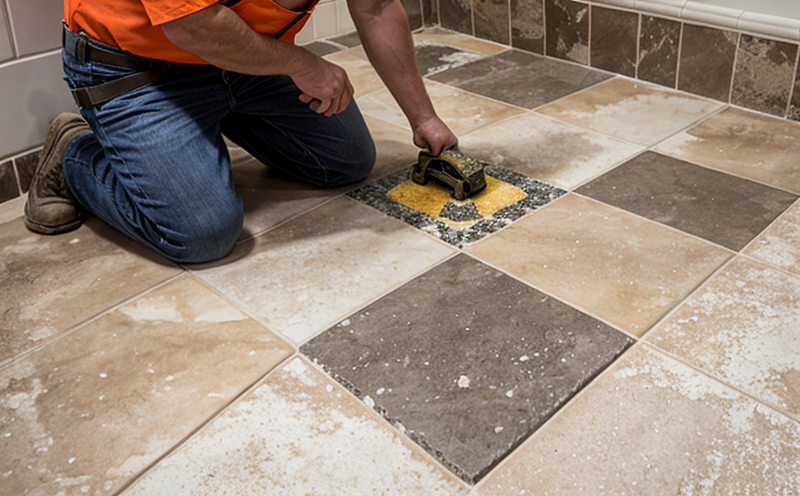Tile and grout inspection
In the construction and building industry, tile and grout are critical components that contribute to the aesthetic appeal and functional durability of a structure. Ensuring the quality of these materials is paramount for longevity and safety. Tile and grout inspection involves detailed evaluation techniques aimed at identifying defects, assessing material integrity, and ensuring compliance with specified standards.
The process begins with thorough visual inspections by trained professionals who look for signs of damage, discoloration, or unevenness in the tiles and grout lines. This initial assessment is crucial as it sets the stage for more detailed testing. Once preliminary checks are completed, a variety of advanced methods may be employed to delve deeper into the quality of materials.
One such method involves destructive testing where small sections of tile and grout are removed and analyzed under controlled conditions. The strength, adhesion, and water resistance properties are evaluated using specific equipment like pull-off testers or water spray chambers. These tests help in determining whether the tiles meet the required standards for structural integrity.
Another significant aspect of tile and grout inspection is the examination of color consistency across different batches or areas within a single project. Discrepancies can lead to visual inconsistencies which are unacceptable in high-quality finishes. Modern technology, including spectrophotometers, aids in accurately measuring and comparing colors ensuring uniformity.
Environmental factors play a vital role too; humidity levels and temperature variations can affect the performance of tiles and grout over time. Therefore, controlled environmental chambers are used to simulate real-world conditions under which tiles will be exposed during their lifecycle. This ensures that any potential issues related to these variables are identified early.
Compliance with relevant standards such as ASTM C1054 for tile grout is essential to ensure consistency and reliability of products across various projects. By adhering strictly to these guidelines, manufacturers and installers can provide assurance about the quality of their work.
| Method | Purpose | Equipment Used |
|---|---|---|
| Destructive Testing | Evaluation of strength, adhesion, and water resistance. | Pull-off tester, water spray chamber. |
| Visual Inspection | Identification of visible defects such as cracks or unevenness. | Trained inspectors' eyes. |
| Spectrophotometry | Measurement and comparison of color consistency. | Spectrophotometer devices. |
| Environmental Simulation | Evaluation under controlled environmental conditions. | Controlled environmental chambers. |
The combination of these techniques ensures a comprehensive evaluation, providing robust data that supports informed decision-making during the procurement and installation processes. This approach not only enhances customer satisfaction but also contributes significantly to reducing warranty claims by addressing potential issues before they become critical problems.
Scope and Methodology
- Destructive testing to evaluate strength, adhesion, and water resistance using pull-off testers and water spray chambers.
- Visual inspection for identifying visible defects such as cracks or unevenness by trained inspectors' eyes.
- Spectrophotometry for measuring and comparing color consistency with spectrophotometer devices.
- Evaluation under controlled environmental conditions in environmental simulation chambers to account for humidity levels and temperature variations.
These methodologies ensure a thorough examination of tiles and grout, guaranteeing their suitability for the intended applications. Compliance with recognized standards like ASTM C1054 further reinforces the reliability and quality assurance provided by this service.
Why Choose This Test
Selecting tile and grout inspection services is essential to ensure that both materials used in construction projects meet high-quality benchmarks. By investing in professional testing, you can avoid costly mistakes down the line which could result from substandard products or improper installation practices.
The benefits of choosing this service extend far beyond mere compliance; it also serves as a safeguard against future maintenance costs and ensures long-term satisfaction for end users. When done correctly, tile and grout inspections play a crucial role in maintaining the aesthetic appeal and functional integrity of buildings over their lifespan.
For quality managers and compliance officers responsible for ensuring adherence to regulatory requirements, this service offers peace of mind knowing that all necessary checks are being performed consistently across different projects. R&D engineers benefit from having reliable data on material performance under various conditions while procurement teams gain confidence in sourcing trusted suppliers who adhere strictly to specified criteria.
Ultimately, selecting tile and grout inspection services demonstrates a commitment to excellence within the construction sector—a key factor that can set apart successful projects from those plagued by issues arising from poor quality materials.





